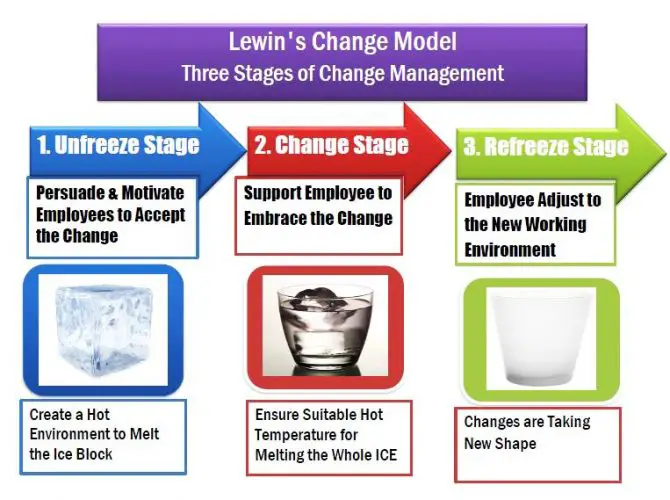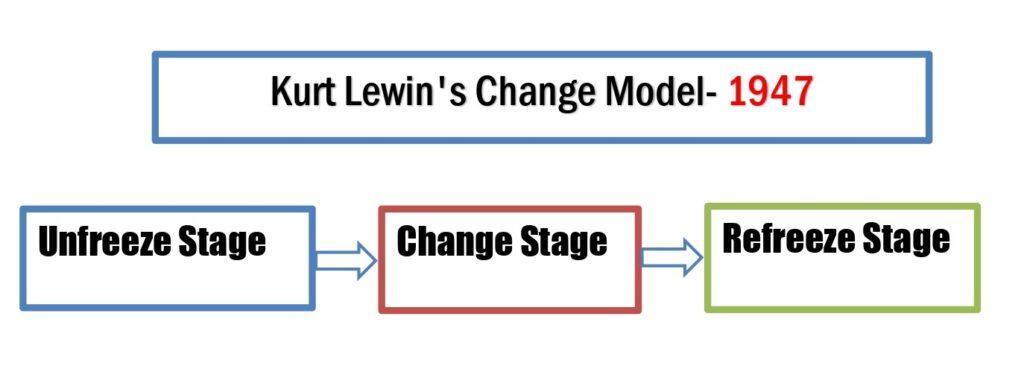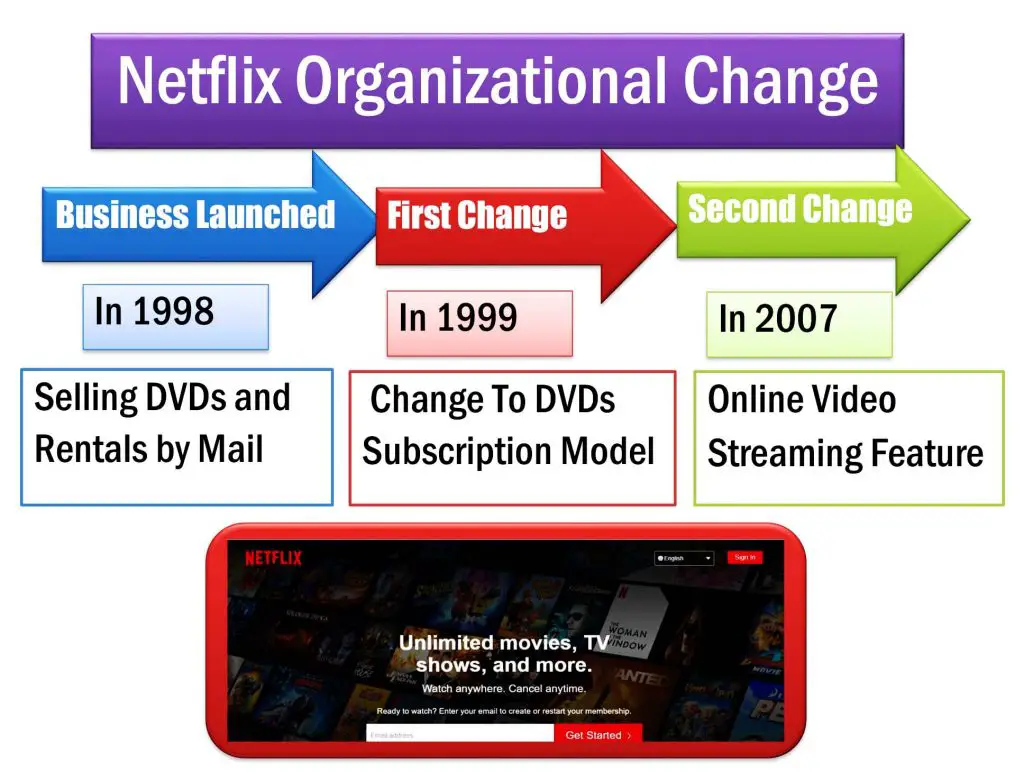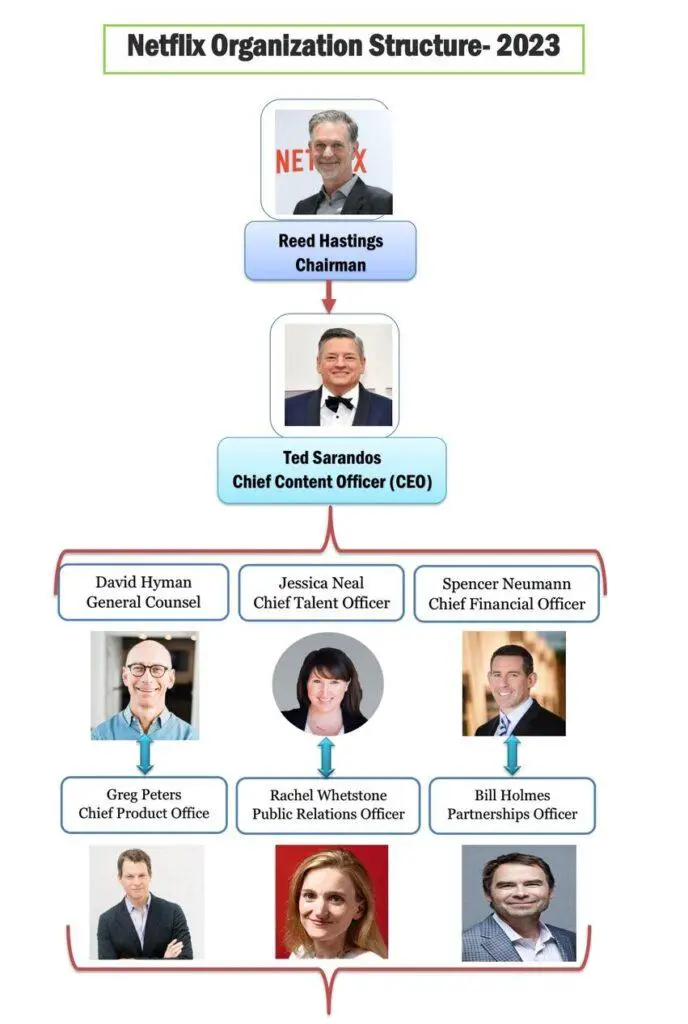Lewin’s Change Model Real-Life Example is Netflix. The Example of Three Stages of Kurt Lewin’s Change Management.
Lewin’s Change Model
Lewin’s change model refers to the three stages of management change theory. The three stages of Lewin’s change management model are unfreezing, changing, and refreezing. Therefore, the alternative name of the Lewin change management model is the unfreeze change refreeze theory. Lewin’s change model is one of the primary and familiar change management models that describe the organizational transition.
Who and When Established Lewin’s Change Management Model?
Kurt Lewin established the three stages of the organizational change model in 1947.
In 1947, Kurt Lewin introduced the three stages of the change management model known as Kurt Lewin’s change model. After that, researchers and scientists established many models to describe organizational changes, such as Kotter’s Change Management Model, Kübler-Ross Five Stage Change Management, ADKAR Change Management Model, McKinsey 7-S Change Management Model, and also Lewin’s Change Model or Theory. However, Lewin’s change management model has become the most popular for its simplicity and fewer phases, for example, unfreeze, change, and refreeze.
Researchers have developed multiple theories based on Lewin’s change management model. So, it is the foundation of all modern change management theories. For example, John Kotter’s 8-stage management change model was developed based on Lewin’s change management model. The management system is complex compared to before when the model was introduced. Therefore, Lewin’s change management model is controversial in modern organizations. It has excellent theoretical significance in the research arena rather than practical importance.
Lewin’s Change Model Real-Life Example
Many reputed companies apply Lewin’s change management model to survive in the current situation. For example, Netflix has used a change model to adjust to the digital era. Netflix’s organizational change process handled the force of organizational change to achieve a competitive advantage. Netflix transformed its business strategy in 1998, 1998, and 2007. The management encountered multiple barriers to getting outcomes. Now, they are one of the most successful companies globally. Netflix is a real-life example of Lewin’s change management model. It is known as Lewin’s Change Model Business Example.
Lewin’s Change Model Stages
Three Stages of Change Management are:
- Unfreeze stage
- Change stage
- Refreeze stage

Unfreeze Change Refreeze
1. Unfreezing Stage of Change
Unfreezing is the initial stage of Lewin’s change management model or Lewin’s change management model. In this stage, employees prepare mentally to accept the change in the organization. In the management system, the unfreeze stage refers to breaking down the existing circumstances to accept organizational changes. Usually, employees feel comfortable in the organization’s current condition; therefore, some do not accept the management change quickly due to uncertainty. The unfreezing stage consists of educating people about opportunities for organizational change. The organization should practice the change management communication strategy to prepare employees for the change.
The key point of this stage is to compel employees to accept management change through effective change communication. Maintaining effective interaction within the management is essential to persuade employees to accept change. Employees will receive the change if they understand the new things cannot prevent the company or organization from surviving. Additionally, they must realize that change is essential to sustain the organization and achieve competitive advantages.
A high level of positive motivation among employees helps to understand the reasons for organizational change and development. Next, the organization needs to persuade the stakeholders that the change will bring benefits to everyone. Some people will receive it quickly, but some of them will deny it initially. Finally, everyone will come up with the motivation to make the change.
Communication During the Unfreeze Stage
The primary communication objective is to prepare stakeholders, employees, and the organization to accept the change – “Readying” the organization. However, resistance will increase simultaneously with how huge the change is and how much it affects the organization. Effective communication can overcome resistance. To ‘ready’ the organization to accept the change, it is essential to declare the objective of the change. Additionally, you must ensure that everyone in the organization knows what will happen and why. Effective communication is significant in pointing out the difference between actual and desired outcomes. This first message or declaration should come from the top-level management of the organization to avoid communication conflict.
2. Change (Move) Stage
Change is the second stage of Lewin’s change management model. It is the middle stage of the three phases of change management. Actual changes occur when everyone in the organization decides to accept the change with positive motivation. Employees receive and adjust to the new working atmosphere. Changes can be major or minor based on the organization’s needs. The organization must provide sufficient training and support for the employees to embrace the changes. It is the stage of implementing the change process; therefore, many issues must be addressed consciously. Some employees may spread misleading information due to having insufficient knowledge about organizational change. So, the organization needs to practice an effective communication process to avoid unwanted issues. However, employees will be focused on practicing the new work.
Communication During the Change Stage
The organization should ensure effective communication among employees to reduce uncertainty as well as organizational communication noise. People may indulge in spreading disinformation and lies with less information about the change process. Therefore, the communication has to have a more specific character than in the previous phase. Communication in this stage is essential to provide authentic, accurate, and detailed information on what will happen to those who have less sketchy details on implementing changes. Finally, it distributes the new responsibility among assigned people in the organization.
3. Refreezing Stage of Change
Refreezing stage of change is the third and final stage of the Kurt Lewin change management model. In this stage, employees adjust to the change of management daily. Refreezing is a slow process of adopting the new culture and atmosphere of the corporate workplace. Employees and stakeholders may take a long time to adjust to the new systems. The pace of the practice among employees determines the time of the refreezing stage. So, refreezing is the most crucial stage in the Lewin change management model. The new attitude and behavior of employees become solidified as the norm of the organization. Finally, everyone starts to feel comfortable as in the previous stage before unfreezing.
Communication During the Refreeze Stage
The communication process should answer employees’ queries regarding rewards, control, efficiency, and relationship roles. In this stage, the information flow should be concrete, continuous, and multidirectional so that employees have a sufficient understanding of the personal associations of the change. Unavoidable misunderstandings may occur in this phase, so; communication should focus on making the transition successful.
Lewin’s Change Model Example
For example, An ice block cannot get converted into a new shape without melting it. So it would be best if you created a hot environment to melt the ice block. The temperature must be more than 32°F (0°C) temperature to melt the ice. So, here, increasing the temperature denotes the unfreezing stage.
According to Lewin’s theory, unfreezing refers to preparation for accepting the new workplace norms. It is the initial stage to get ready to accept the change. The management needs to motivate employees to accept change.
It will take time to transform the entire ice block into water. Keep the glass isolated and ensure the temperature is suitable for melting ice. When the ice block completely transforms into water, pour it into a new pot to give it a unique shape. Here, pouring the water into a glass is changing steps or moving stage. Melting the ice denotes the change stage of Lewin’s theory.
According to Lewin’s theory, changing refers to accepting new norms and moving on to change. Thus, the employee starts to change and accept the new culture of the workplace.
Finally, keep the glass in a cold place to transform the water into ice again. It is the way of freezing the water to transform it again into a new solid shape. It is called the refreezing process and the final stage of Lewin’s change management model.
Refreezing refers to adjusting to the new norms of the workplace. The employee has already accepted the change, and they adapt to the new environment.
The model summarized that successful management change is accomplished through a three-stage process; unfreezing, changing, and refreezing.
Lewin’s Change Management Model Example
For example, the educational institute has shut down due to the COVID-19 pandemic. Therefore, all organizations, including educational institutes, decided to conduct virtual or online classes to ensure the continuation of education for students. These educational institutes are applying online video meeting platforms, such as Zoom and Google Meet, to conduct virtual classes and organizational meetings. It was a new experience for lecturers; therefore, they were afraid of uncertainty and interested in taking online courses. But, the university authority compels them to accept the change. The university authority maintains effective communication through social media platforms to motivate employees to get change. They thought the organizational change would help achieve competitive advantages as the other educational institutes adopted it. So, finally, they accept the change and adjust to the new working environment. It is a perfect example of Lewin’s Change Theory.
Lewin’s Change Model Pros and Cons
Lewin’s Change Management Model Strengths and weaknesses
Lewin Model Advantages
Firstly, Kurt Lewin’s model is straightforward to understand; any organization can implement it efficiently. The management need not hire experts to execute the model. The existing employees will be able to apply it and evaluate the outcome. It has only three stages: unfreeze, change, and refreeze, so it is easy to understand and apply. For example, the McKinsey 7-S model has seven elements that are challenging to implement.
Lewin Model Disadvantages
Firstly, refreezing takes a long time to settle down with new norms. Additionally, many employees quit their job due to uncertainty regarding the latest norms and environment. Lewin’s theory excludes many crucial elements, such as staff, structure, strategy, system, and style.
Kurt Lewin 1951 References
Citation for this Article (APA 7th Edition)
| Kobiruzzaman, M. M. (2024). Lewin’s Change Model- Lewin’s Change Management Model of 3 Stage. Educational Website For Online Learning. https://newsmoor.com/lewins-change-model-3-steps-management-change-and-communication/ |


